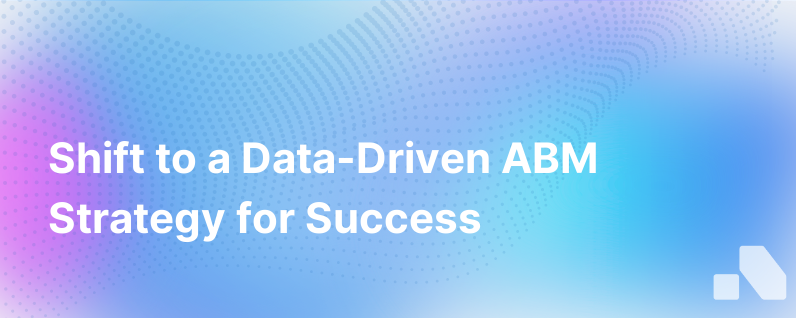
Account-based marketing (ABM) has revolutionized the B2B marketing landscape, allowing marketers to create highly personalized campaigns focused on individual accounts or segments. While tactics are the acts that make up the rhythms of your campaigns, a comprehensive ABM strategy draws from robust and actionable data. To drive optimal performance, it's important to transition from standalone ABM tactics to a data-driven ABM program, where insights fuel every decision.
Let's explore what it means to make this shift, the advantages it brings, and how to institute a data-driven ABM program that aligns with your sales goals.
From Tactics to Strategy: The Evolution of ABM
Traditional ABM tactics often involve one-off campaigns or ad-hoc initiatives aimed at targeted accounts. While these can yield results, they don't harness the full power of ABM. With a data-driven approach, on the other hand, decisions are made based on insights drawn from real-time customer data.
The key to a successful data-driven ABM program lies in understanding that strategy precedes action. This means identifying high-value accounts, understanding the customer journey within those accounts, crafting personalized engagement strategies, and nurturing those relationships to fruition, all through a lens of data.
The Benefits of a Data-Driven ABM Program
Adopting a data-driven strategy has multiple benefits. When you harness data effectively, it can help you:
- Improve Targeting: By understanding your ideal customer profile (ICP) using empirical data, you can more accurately identify high-value targets.
- Enhance Personalization: Leverage data insights to create content and messages that resonate deeply with your targets on an individual level.
- Drive Alignment: Sales and marketing alignment is critical in ABM. Shared data gives both teams a common language and shared milestones.
- Measure and Optimize: Data provides the metrics needed to track success and adjust your campaigns for maximum ROI.
- Scale with Predictability: Over time, you'll accumulate historical data that can help predict outcomes and inform resource allocation.
Steps to Shift to a Data-Driven ABM Program
Transitioning from a tactics-focused approach to a data-driven ABM program requires planning, the right tools, and a commitment to continual improvement. Here are the steps to make that happen:
1. Assess the Current State
Before you can move forward, it's essential to understand where your current ABM operations stand. This involves evaluating your existing ABM tactics, the technology stack you're using, and how well your sales and marketing teams are aligned. Look at the quality and accessibility of your current data and establish baseline performance metrics for future comparisons.
2. Define Goals and KPIs
What do you want to achieve with ABM? More engaged prospects? Larger deal size? Shorter sales cycles? Define clear goals, and identify the key performance indicators (KPIs) that will help measure them. These goals and KPIs should align closely with broader company objectives.
3. Data Integration & Technology
Your ABM program's efficacy hinges on the accuracy and integration of your data sources. Invest in a tech stack that enables this integration, allowing for a holistic view of customer interactions across touchpoints. A customer relationship management (CRM) system, marketing automation tools, and platforms like Aomni that specialize in real-time account data can provide the level of insight necessary for a data-driven approach.
4. Ideal Customer Profile (ICP) Development
Use data analytics to refine your ICP. Gather quantitative and qualitative data to compile a detailed description of the companies that are most likely to benefit from your solution. Look for patterns in your existing customer base to identify the characteristics of your most successful engagements.
5. Account Selection and Prioritization
Using your ICP, identify and prioritize accounts with the highest propensity to buy and the largest potential deal size. This may involve scoring accounts based on fit, intent signals, and engagement levels.
6. Customized Content and Messaging
Generate content and messaging that aligns with the challenges and objectives of your target accounts. Utilize data insights to guide the topics, formats, and channels that will be most effective.
7. Orchestrate Multi-channel Campaigns
A successful ABM program effectively orchestrates campaigns across multiple channels for a seamless customer experience. Data can guide when and where to engage with accounts, from social media and email to web personalization and digital events.
8. Align Sales and Marketing Efforts
Sales and marketing teams must collaborate closely, using the same data to guide their efforts. For instance, if marketing campaigns generate engagement from specific accounts, sales should have immediate visibility into these activities and follow up accordingly.
9. Continual Learning, Testing, and Refinement
Data is not just about insight; it's about enabling a culture of continual learning and refinement. Regularly test different approaches and use analytics to understand what works and what doesn't. This iterative process will optimize your ABM program and increase its impact over time.
10. Track, Analyze, and Report
Constant measurement is integral to a data-driven approach. This means tracking progress against KPIs, conducting analyses to understand success drivers, and reporting outcomes to stakeholders across the company. The reporting should connect ABM efforts to revenue outcomes, proving ROI and justifying future investments.
Conclusion
Shifting to a data-driven ABM program doesn't happen overnight. It requires a foundational change in approach—moving from isolated tactics to comprehensive, insight-led strategies. By highlighting the advantages of this approach and outlining actionable steps, we aim to guide B2B startups through this pivotal transformation.
Remember, as you embark on this journey, leveraging AI and technology such as Aomni for real-time account insights can fast-track your progress and enable better-informed decision-making. The results will be more efficient campaigns, deeper customer relationships, and, ultimately, a more significant impact on your bottom line.